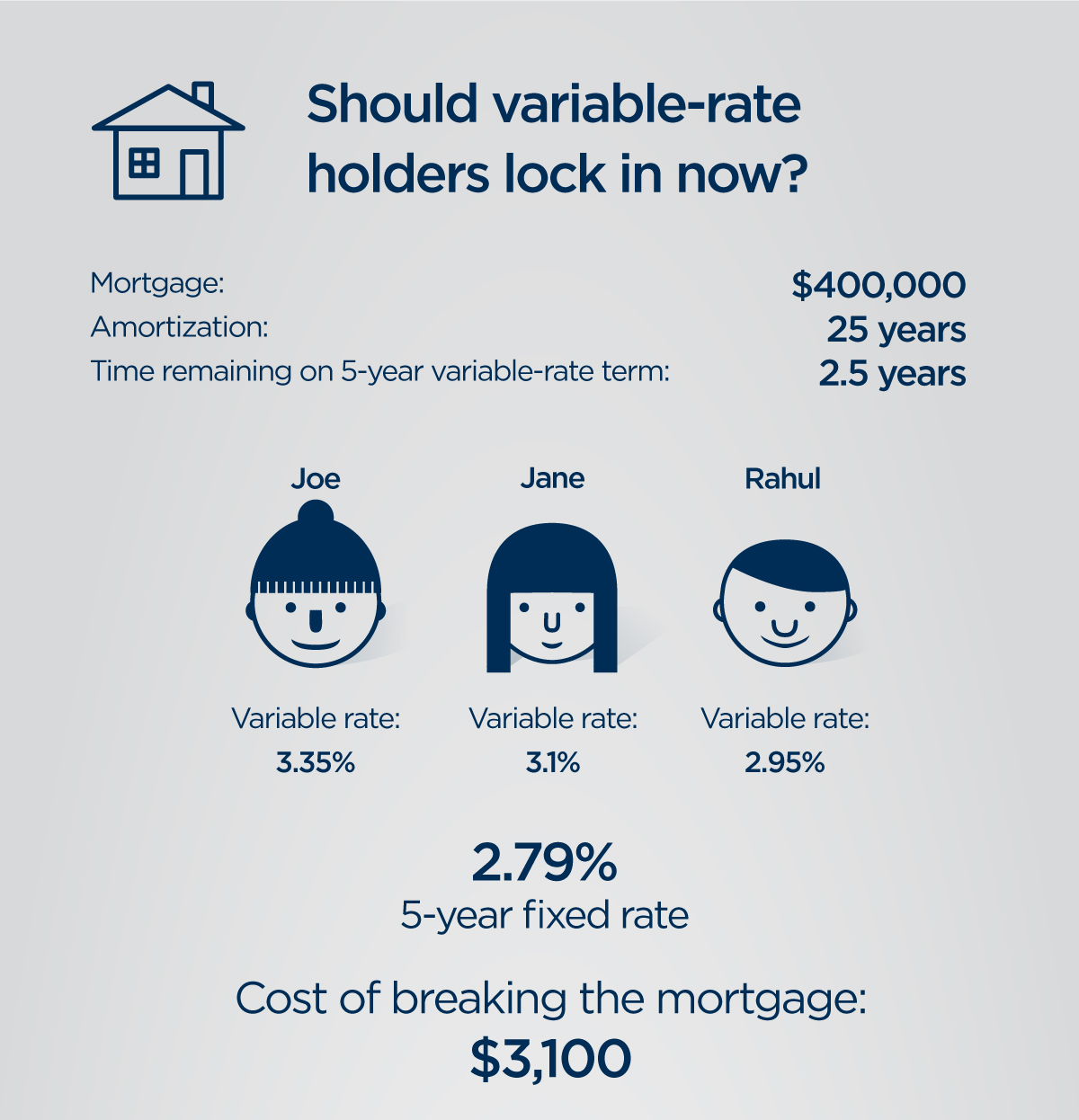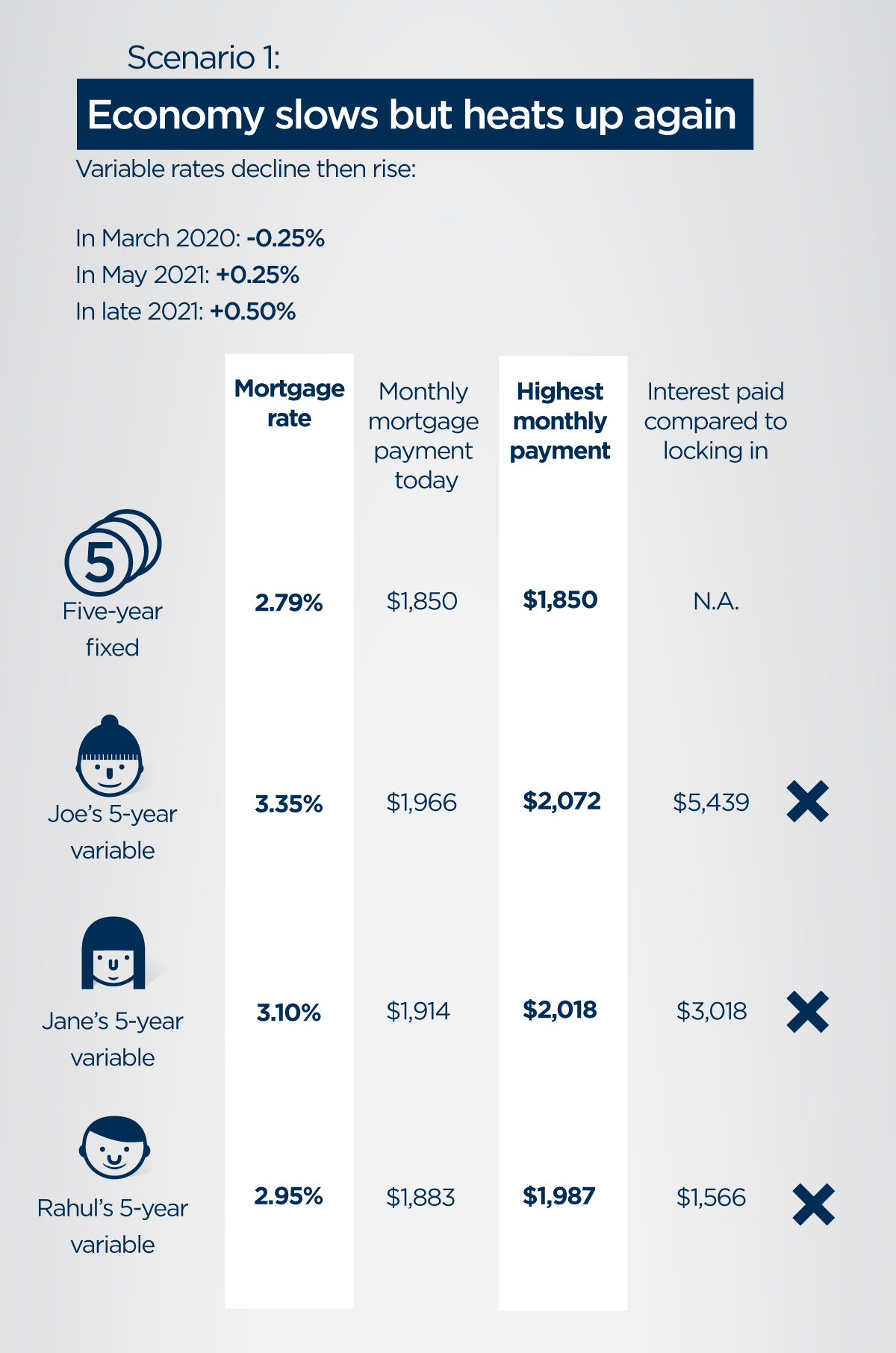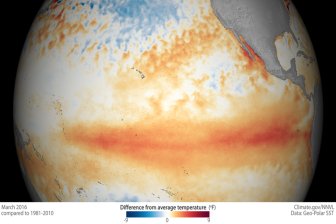Normally, switching from a variable rate to a fixed one before the end of your mortgage term means signing up for a higher rate. Fixed mortgage rates are usually higher than variable rates because people are willing to pay extra for the comfort of knowing their interest rate will not change.

For months, though, fixed mortgage rates have dipped below variable rates, a rare occurrence that reflects investors’ worries about the possibility of a future recession in the U.S. and Canada.
READ MORE: With fixed rates below variable ones, mortgage market is in the Upside Down
For example, the lowest nationally available five-year fixed rate for a conventional mortgage currently is 2.79 per cent, according to Robert McLister, founder of rates-comparison site RateSpy.com. The lowest variable rate for a five-year term is 2.89 per cent.
This means variable rate holders with a five-year mortgage term can lock into a five-year fixed rate that is lower than their current rate. And what’s better than getting a better rate and the peace of mind of a fixed mortgage payment?
Not so fast, some mortgage brokers say. Locking into a lower rate won’t necessarily save you money.

The ‘locking in’ math — three scenarios
To illustrate the concept, Toronto mortgage broker David Larock ran the numbers for three future scenarios in a recent blog post.
Take three homeowners — let’s call them Joe, Jane and Rahul — each with an outstanding mortgage balance of $400,000 and two and a half years to go on their five-year variable-rate mortgage.
Joe’s variable rate is pegged at a discount of 0.6 per cent to the prime rate, a benchmark rate used by lenders. Based on the current prime rate of 3.95 per cent, Joe’s rate is 3.35 per cent today.
Jane got a slightly better deal, with a variable rate of prime minus 0.85 per cent, meaning her current variable rate is 3.1 per cent.
READ MORE: 3 tips that could save you thousands on your mortgage
Rahul has the best rate — prime minus one per cent — and is paying a rate of 2.95 per cent.
All three could switch to a fixed rate of 2.79 per cent today. But should they?
Larock’s math shows locking in may not be a good idea if the economy sours.
Scenario one: the economy slows down but then picks up again
In the first scenario Larock imagined, interest rates initially dip 0.25 per cent in early 2020 as U.S. growth slows, which prompts concerns about Canada’s own economic health. Happily, though, things pick up again after the U.S. federal election, and rates climb 0.75 per cent through 2021.
In this scenario, locking in would save money to all three variable-rate holders in our example. However, if they had to break their mortgage and pay $3,100 in penalties in order to access a low 2.79 per cent five-year fixed-rate, only Joe would come out ahead.
Borrowers can convert their variable-rate into a fixed one at their existing lender, which avoids any penalties. However, they’d be “at the mercy of the lender,” who may not offer them a competitive rate.
Breaking the mortgage means becoming “a free agent” able to shop around for the best available rate, Larock said. The catch, though, is you’d have to pay a penalty and, if you’re applying for a new loan with a federally regulated financial institution, qualify for the stress test with the new lender.
Scenario two: the U.S. dips into recession
In this scenario, Larock looked into what might happen if the U.S. economy dipped into recession, dragging down Canada’s economy as well. The Bank of Canada might lower its trend-setting interest rate by 0.75 of a percentage point, from 1.75 per cent to one per cent in several cuts throughout 2020. However, lenders pass on just some of those savings to consumers, as they did when Canada’s central bank last cut rates in 2015. As a result, variable rates dip just 0.45 per cent overall through the course of the year.
In this scenario, the difference between locking in and staying put would be minimal for all three borrowers two and a half years down the line. However, by switching to a five-year fixed rate, they’d still have half of their mortgage term to go at 2.79 per cent at a time when more competitive rates might be available, Larock noted.
“Staying put now, even at a higher comparable rate, would likely still leave all three variable-rate borrowers better in the long run.”
Scenario three: a more severe U.S. recession
If the U.S. economy plunged into a more serious funk in the next few years, the Bank of Canada may be forced to lower its key rate by a full percentage point, with lenders passing on 80 per cent of the cost savings, Larock writes.
READ MORE: The deal hunter’s guide to getting the lowest mortgage rate
In this scenario, all three borrowers would be better off sticking to their variable rates. Not only would they save on interest by sitting tight, but their mortgage would come up for renewal at a time when interest rates would likely be very low, according to Larock.
“In this situation, it would be better for variable rate borrowers to stay the course. Time would be on their side.”
How to decide whether you should switch from variable to fixed
The bottom line is, if interest rates start to fall again, existing variable-rate mortgage holders who sit tight could come out ahead, according to Larock.
That could well happen in the near future. The fact that fixed interest rates are currently lower than floating rates means that investors expect short-term interest rates will fall, McLister said.
Historically, variable rates have delivered savings compared to fixed rates the vast majority of the time, he added.
However, “when it comes to rate direction, what we know for sure is that we know nothing for sure.”
There are other ways to evaluate whether switching to a fixed rate makes sense. For example, if your financial situation has deteriorated and locking into a fixed rate would lower your anxiety levels, the move might be worth it, McLister said.

On the other hand, if you’re simply trying to time the market, “that’s a wild-goose chase and you probably weren’t cut out for a variable in the first place,” McLister said via email.
Still, “if you’re stuck in a costly variable (e.g., prime – 0.60 per cent), you need to evaluate whether refinancing into a much lower rate is worth paying a penalty for. It often is.”
But even then, there are exceptions. A borrower with a relatively costly variable rate who only had a short time left to the end of their mortgage term may be better off staying put, Larock said.
For example, someone with just six months left on their mortgage term would be able to sign up for a fixed rate within 120 days of their renewal date and ask the lender to hold it, he added.
On the other hand,
“If I had a variable rate of prime minus (0.60 per cent) and four years left on my term, then the cost of that uncompetitive rate is magnified by the time remaining on the mortgage.”








Comments